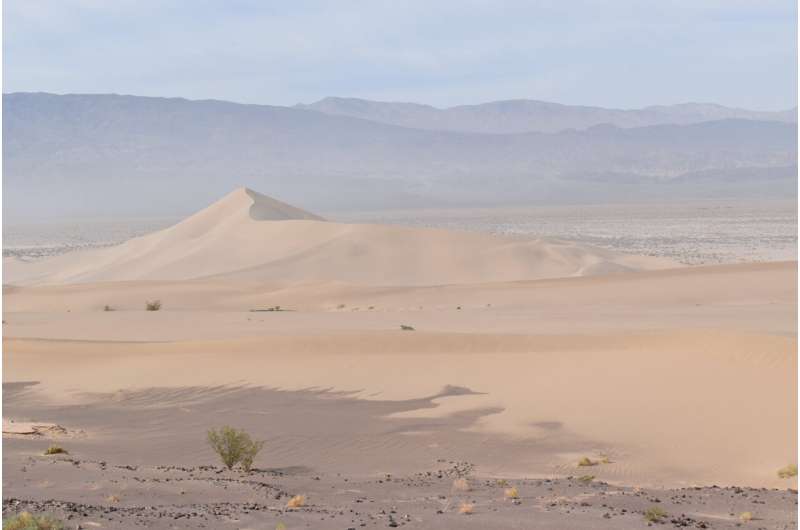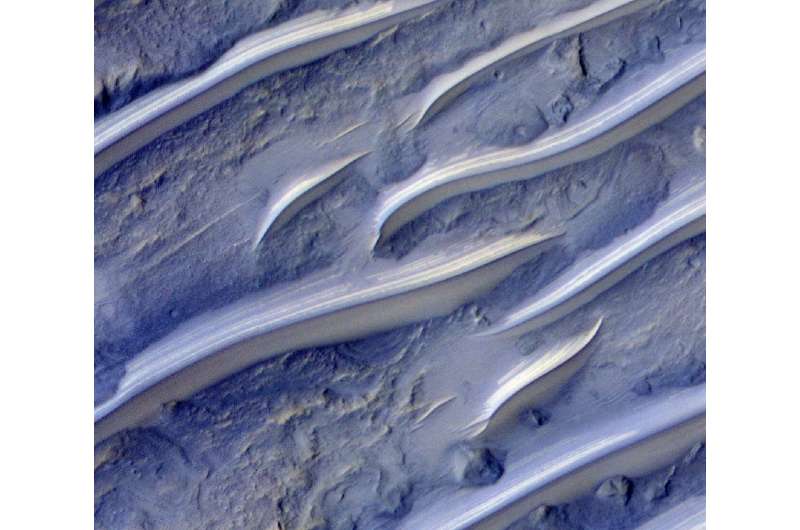Dunes on Earth behave very similarly to dunes on Mars. In the featured Geology article, Mackenzie Day uses dunes on both Earth and Mars in tandem to better understand how sand moves in wind. Credit: Mackenzie Day.
Dunes develop when wind-blown sand organizes into patterns, most often in deserts and arid or semi-arid parts of the world. Every continent on Earth has dune fields, but dunes and dune-like sand patterns are also found across the solar system: On Mars, Venus, Titan, Comet 67P, and Pluto. On Earth, weather stations measure the wind speed and direction, allowing us to predict and understand airflow in the atmosphere.
On other planets and planetary bodies, we do not yet have weather stations measuring the winds (with a few recent exceptions on Mars only). Without a way to directly measure wind on the surface of another planet, we can use the patterns in dunes to interpret what the wind must be doing, based on our knowledge of dunes on Earth. Furthermore, by studying dunes across planets, we can get a better understanding of how wind and sand behave in general.
In a Geology paper published today, Mackenzie Day of the University of California Los Angeles focuses on what happens when two dunes collide.
"On Earth, we know that dunes collide, combine, link, and merge all the time," says Day. This is what drives changes in dune-field patterns over time. When this happens, the dune-dune interaction leaves behind a particular pattern in the sand, but that pattern is usually covered by actively moving sand and difficult to see without special tools."
On Mars, many dunes look and behave similar to dunes on Earth, but in addition Mars hosts patterns of organized sand that are dune-like but have some differences that have yet to be explained by the scientific community. Whether or not these unusual features, sometimes called "transverse aeolian ridges" or "megaripples," are formed like dunes has been long debated.
Sand on Mars forms dunes and dune-like features, as seen here in a satellite photo from the Iapygia Quadrangle of Mars. Banding on the back of these dune-like features indicated that they are migrating toward the lower right in the image and the wind is form the upper left. Credit: NASA/U of A., HiRISE camera image ESP_020782_1610.
"In this work," says Day, "I show that these unusual wind-blown sand ridges sometimes show on their surfaces the pattern that forms when two dunes combine."
In the Iapygia region of Mars, transverse aeolian ridges incorporated both light and dark sands, leading to light-dark banding in the upwind side of the ridges. Banding occurring only on one side of the ridges suggests that the banding formed as the ridges migrated. Furthermore, the dune-interaction pattern known from Earth can be seen in some ridges where the banding is truncated and then reconnects, just like two dunes touching and then combining downwind.
The pattern associated with dune-interactions only forms when two dunes combine. Therefore, seeing it in these Martian sand ridges demonstrates that these enigmatic features behave like dunes on Earth. "Just like dunes on Earth, transverse aeolian ridges on Mars migrate, combine, and develop complex patterns in response to the wind."
Transverse aeolian ridges are incredibly common on Mars, and the results of this work allow us to better interpret the wind at the surface of Mars using these dune-like features.
"Overall," Day says, "this work leverages both knowledge of Mars and knowledge of Earth to understand the other planet and opens the door to improving how we interpret wind across planetary bodies further into the solar system."
More information: Mackenzie Day, Interaction bounding surfaces exposed in migrating transverse aeolian ridges on Mars, Geology (2021). DOI: 10.1130/G49373.1
Journal information: Geology
Provided by Geological Society of America

























